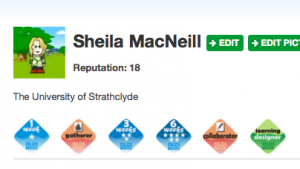Bill Clinton isn’t the only one creating a buzz about the open badges movement at the moment. Perhaps with slightly less coverage than the Clinton initiative, yesterday saw the first (Scottish) open badges working group meeting.
Organised by Grainne Hamilton at RSC Scotland, following the success and interest shown at their recent Open Badges Design Day, the meeting was very well attended with a group of really enthusiastic practitioners from across the Scottish education sector, many of whom are already implementing badges. There was also good representation from key agencies such as the SQA and the Colleges Development Network.
What struck me about the meeting was how much real buy-in and activity there was for badges from schools to colleges to universities. Whilst there was a lot of diversity in approaches (most people implementing badges are still at pilot stages), there were also a number of common themes of interest for future developments including badges for staff development purposes and the sharing of implementation of “badging” through VLEs in particular Moodle and Blackboard.
One of the great selling points of badges is their potential to bridge the gap between achievement and attainment of formal qualifications and give people (and in particular students) more opportunities to present things which aren’t recognised through formal qualifications. This was a prime motivator for many at the working group as they want to be able to allow students more ways to showcase/sell themselves to potential employers, and not have to rely on formal qualifications. This of course links to developments around e-portfolios.
There was also a lot of interest in using badges for staff development within colleges and universities. RSC Scotland is already paving the in this respect as they have developed a range of badges for their online courses and events, and a number of colleges are beginning to use badges for staff development activities.
Over the coming months a number of sub-groups will be forming around some of the key areas identified at yesterdays meeting, setting up a shared workspace and of course, most importantly sharing their work with each other and the wider working group, and of course the rest of the community.
If yesterday afternoon was anything to go by, there will be lots more to share around the development and implementation of badges. I’m certainly looking forward to being part of this exciting new group, and thanks again to Grainne and Fionnuala and the RSC for bringing this group together and their commitment to supporting it over the coming year.


